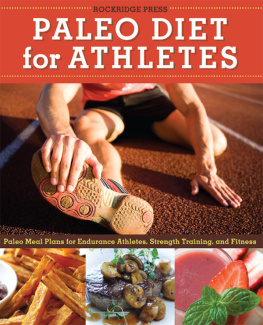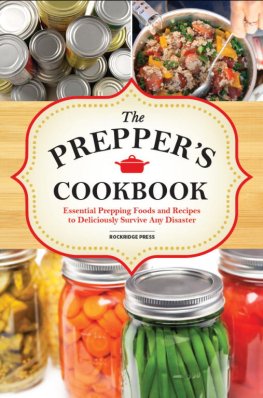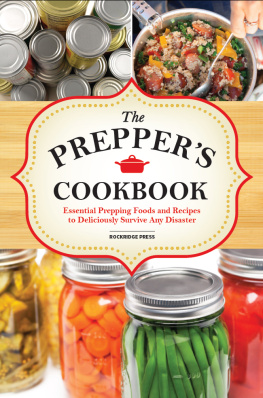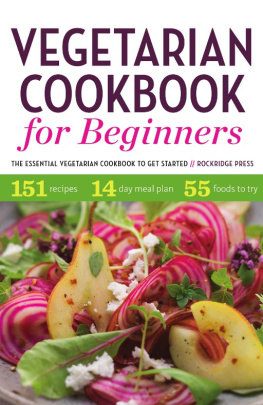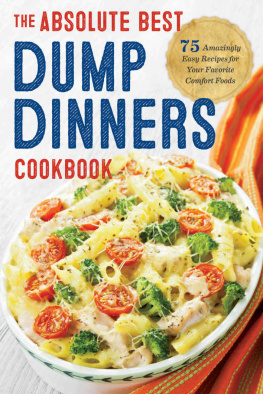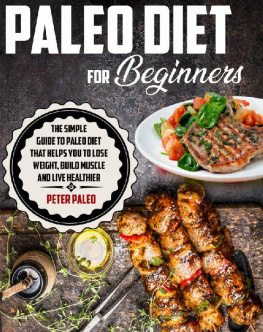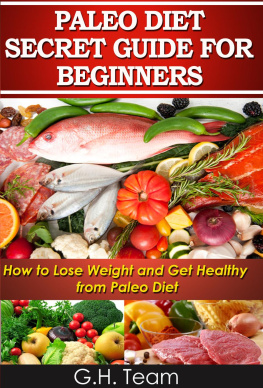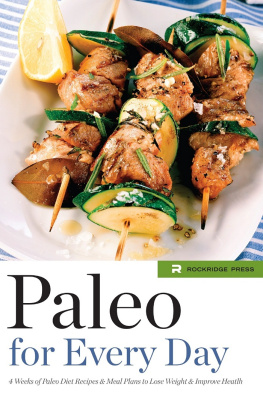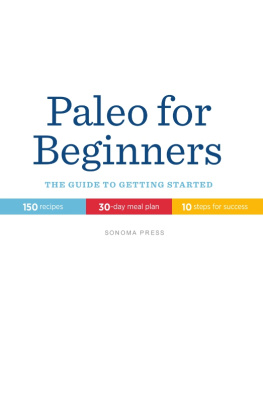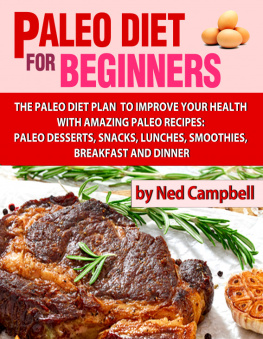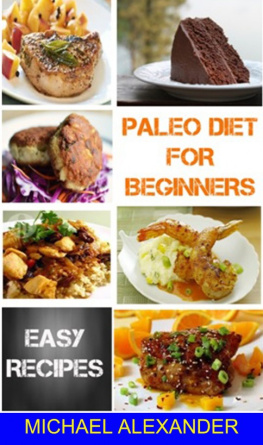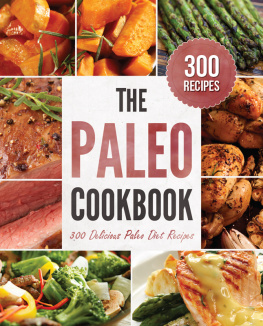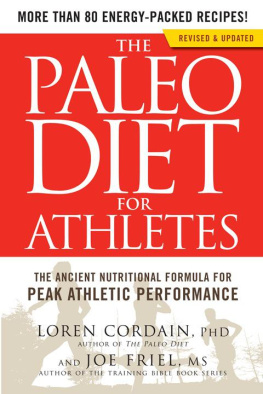INTRODUCTION
I f youre looking for a great way to clean up your diet and complement your workout plan, youve come to the right place. The Paleo diet is a wonderful approach to eating healthfully without sacrificing flavor or feeling deprived. Youll eat plenty of lean proteins and quality carbohydrates that will help you maximize the benefits of every single training session. Youll also skip the gluten and low-quality, processed carbs associated with many training diets. Instead, youll opt for natural foods that provide long-term energy and promote muscle repair and growth.
Its pretty much a given that without proper nutrition, youll never be able to gain the strength and endurance needed for training to maximum capacity. The problem is, with so many diets and magic pills out there, its nearly impossible to sift through them all to find one that will be effective long-term. The key is to go with simplicity and common senseboth hallmarks of the Paleo diet.
Whether youre training for a marathon, working to build lean muscle, attempting to lose weight, or just trying to stay fit and healthy, the Paleo diet makes for an easy, delicious component of a healthful lifestyle. Throughout the pages of this book, you will learn what constitutes the Paleo diet and why its a great plan to help you meet your fitness goals. Youll also find a variety of appetizing recipes arranged in meal plans designed specifically for your needs.
Without further ado, lets learn how to eat caveman-style!
SECTION ONE
What Is a Paleo Athlete?

THE BENEFITS OF PALEO FOR ATHLETES
B efore delving into recipes and meal plans, its important to understand the definition of the Paleo diet and how it can improve your athletic performance more than traditional diets that require carb-loading and fasting. After all, common misunderstanding is part of the reason its so difficult for many to choose a healthful way to eat; you cant be expected to blindly follow a program when you dont know how and why it works!
Whats the Theory Behind the Paleo Diet?
The Paleo diet isnt actually a diet in the traditional sense of the word. There are no calorie restrictions, and youre welcome to eat as much as you want anytime that youre hungry. The Paleo diet is more of a lifestyle. Of course, since the focus of this book is on how to best feed your body for athletic performance, the concentration will be at least somewhat on quantities of food as well as types, but in general, the typical Paleo eater isnt calorie restricted.
Also known as the caveman diet and the Stone Age diet, the Paleo diet is based on the premise that there are foods that are optimal for our bodies and others that are less so. Our bodies havent altered much in the last ten thousand years or so, but the way we eat has. For eons, humans survived on basic foods such as lean proteins, fruits, vegetables, nuts, and seeds that could be hunted or gathered.
Our bodies were well adapted to these types of foodsthen BAM! The agricultural age hit, and then the industrial revolution began in the late eighteenth century, introducing refined sugars and processed grains to the civilized world. Our diets transformed from whole, natural, foraged foods to one based largely on processed grains, legumes, and dairy. In the scheme of things, ten thousand years is only a blink in time, and our bodies havent yet adapted to this change in eating.
In an interesting side note, the agricultural revolution didnt just change our diets; it also changed us from a species of constantly active hunters and gatherers to a more sedentary people who stayed in one place and worked in spurts. This change is also noteworthy from the standpoint that digestion and exercise go hand in hand.
What Is the Paleo Diet?
As noted above, the industrial revolution didnt just change the way we eat, it turned us into people who no longer had to remain active to survive. Consequently, diseases such as obesity, diabetes, heart disease, and various gastric disorders began to explode to near epidemic proportions. These diseases, often referred to as diseases of affluence, became so prevalent that a gastroenterologist named Walter L. Voegtlin made the connection between these conditions and the change in diet.
In an effort to help his patients, he recreated a diet based upon his belief that our bodies simply had not adapted to eating refined, processed foods. Lo and behold, a large majority of his GI patients showed significant improvement once they switched back to the hunter-gatherer style of eating, and the Paleo diet was born.
Why Is Paleo-Style Eating Better Than Traditional Carb-Loading?
Many people use the terms fitness and health interchangeably, but one does not necessarily equate to the other. For instance, how many athletes have tragically died from undiagnosed heart disease or complications caused by poor diet, performance-enhancing drugs, or just flat-out bad luck? Those people were likely extremely fit, but they most certainly werent as healthy as they could have been. It seems pretty obvious that your goal should be to achieve both health and fitness, and the Paleo diet can help you accomplish this.
Why Traditional Carb-Loading Isnt the Best Way to Prepare
The vast majority of traditional training meal plans will load you up with breads, pastas, and other simple carbohydrates in the last few hours leading up to a big competition. The idea is that simple carbs are easily converted into energy that your body can use to keep you going; however, this theory has some holes in it.
First, simple carbs do provide quick energy, but the key word here is quick. Like a sparkler on the Fourth of July, your energy burns fast and hot but fizzles out fairly rapidlythen you crash. Thats not exactly ideal when you need to continue on for several hours. Even though youll most likely reload at some point, its better to have a sustained energy source as well as a quick one.
Another issue with traditional carbs from pastas and breads is gluten, which is a protein found in grains that can cause different levels of gastric distress in many people. Gluten isnt the only problematic component of grains, either. Certain ingredients in grains can actually prevent your body from absorbing valuable nutrients from the fruits and vegetables you eat. Carb-loading with grains simply isnt the ideal way to eat if youre trying to prepare properly for an athletic event.
So How Does the Paleo Diet Get You Ready to Roll?
Right out of the gate, youre going to be healthier if youve been living the Paleo athletes lifestyle. Youll be free of toxins and the garbage your body cant digest. Your digestive tract will be clean and your circulatory system healthier so you can efficiently transport oxygen throughout your body. Physiologically, your body will be the well-oiled machine it needs to be heading into competition.
Prior to a race, match, etc. of any kind, youre going to be eating foods that are not only rich in complex carbohydrates, but also contain healthful amounts of protein that will provide sustained energy to get you through your event. When you combine your increased health and fitness with the proper fuel your body needs to efficiently create both quick and long-term energy, the Paleo diet is, without a doubt, the best way to go.
How Does the Paleo Diet Aid Athletic Performance?
High levels of exercise are extremely stressful to your body, especially if youre not nourishing it properly. Acidosis (the accumulation of lactic acid in muscles) that occurs during extreme exercise, damages bones and suppresses the immune system, while inflammation from tissue damage can interfere with healing and even breathing. Intense exercise can also drain your body of valuable minerals it needs for survival.

